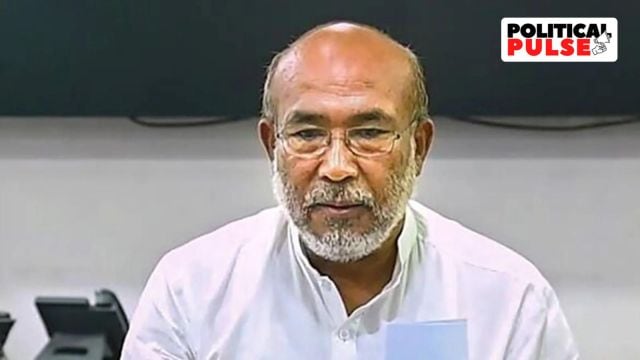Decode Politics: Why new districts created in 2016 talking point now in strife-torn Manipur
Nagas had opposed the district reorganisation as encroaching on their land, their anxieties have been exacerbated by the Kuki-Zomi assertion in the current conflict
 Singh’s statement comes after massive protests rocked Imphal, with angry mobs targeting the homes of ministers and MLAs, including Singh’s personal residence in Heingang.
Singh’s statement comes after massive protests rocked Imphal, with angry mobs targeting the homes of ministers and MLAs, including Singh’s personal residence in Heingang.During the recently concluded Session of the Manipur Assembly, Chief Minister N Biren Singh said it was necessary to reorganise districts in the state, terming the 2016 decision of the Okram Ibobi Singh-led Congress government to carve out seven new districts as “driven by political interests”.
The 2016 move had not gone down well with the Nagas, who alleged that the demarcation encroached into their ancestral lands, and triggered a 139-day blockade of two highways leading into the state by the United Naga Council and other Naga groups.
However, the move also presented the Naga groups an opportunity to gather support from the Kuki-Zomis ahead of the state elections a year later, in 2017.
With the state in the grip of the ethnic conflict between the Meiteis and Kuki-Zomis for over a year, what impact will the Biren Singh government’s proposal to reorganise districts have, including on the political landscape of the state?
What changed in 2016?
Citing the need for administrative efficiency and the long-standing demands of locals,, the Ibobi Singh government, through a notification in December 2016, created new districts by bifurcating seven of the nine districts of the state, months ahead of the Assembly elections.
Before the reorganisation, the Meiti-majority valley had four districts – Imphal East, Imphal West, Thoubal and Bishnupur – while the remaining five districts of Ukhrul, Senapati, Chandel, Tamenglong and Churachandpur were tribal-majority hill districts. Churachandpur was dominated by the Kuki-Zomi tribe, while the remaining four were Naga-dominated.
In the reorganisation, Pherzawl was carved out of Churachandpur, Kamjong, Noney; and Tengnoupal was carved out of Ukhrul, Tamenglong and Chandel respectively. A new district, Kakching, came into being in the valley, while a geographically non-contiguous part of Imphal East in the western-most part of the state was carved out as Jiribam district.
The most contentious issue was the creation of the Kuki-Zomi dominated Kangpokpi district, carved out from the Naga-dominated Senapati district in the Sadar Hills region of the state.
What were the prevailing political circumstances?
Ahead of the 2017 Assembly polls, the Congress, in power in the state since 2002, faced an exodus of prominent leaders, including its former vice-president (and current BJP CM) Biren Singh.
The government had faced massive protests in the hills, which had left eight dead in Churachandpur, after three bills had been passed in the legislative assembly in 2015. The three bills were essentially supposed to be a substitute for an Inner Line Permit regime for the state – which was not in place in Manipur at that time and was only introduced in 2020 – after agitations for it by Meitei groups in the valley but they were met with suspicions by tribal groups in the state – whose land already have constitutional protections – which suspected that these could infringe on their land rights.
What was the basis of the opposition to the new districts?
The United Naga Council along with the largest insurgent group of the northeast, the NSCN (I-M), opposed the creation of the new districts, accusing the Okram Ibobi government of “appropriating” Naga villages and merging them with non-Naga areas. They also claimed that the Hills Areas Committee, which comprises all MLAs from the hill areas of the state, was not consulted on the issue.
Many saw the move as an attempt by the Congress government to win over Kuki-Zomi groups ahead of the elections, at the expense of Nagas’ interests.
The opposition to the new districts continues to this day. Meanwhile, the demand by Kuki-Zomi groups to have a separate administrative regime for their areas, following Manipur’s ethnic violence, has aggravated the Naga anxiety over their lands.
How did the issue come up in the Assembly?
Expressing concerns over the creation of the Kangpokpi district and emphasising on the contentious history and ongoing dissatisfaction among the Naga communities, Naga People’s Front MLA Leishiyo Keishing moved a calling attention motion on the issue on the last day of the Assembly session on August 12.
Speaking on the issue, CM Biren Singh said that though the previous Congress government cited administrative efficiency as the reason for creating the new districts in 2016, this was based on ethnic lines and “such mistakes, when left unaddressed, gave birth to further ethnic divide”.
“People do not consider themselves as Manipuri first. A community which is in majority in a particular district consider themselves as the owners of the land,” he said and claimed that Naga residents of Kangpokpi and Churachandpur have voiced concerns over lack of essential services and opportunities, and illegal taxation.
The CM also assured that the district boundaries would be reorganised based on “genuine administrative convenience” and after consultations with civil groups and leaders of tribes.





- 01
- 02
- 03
- 04
- 05


























